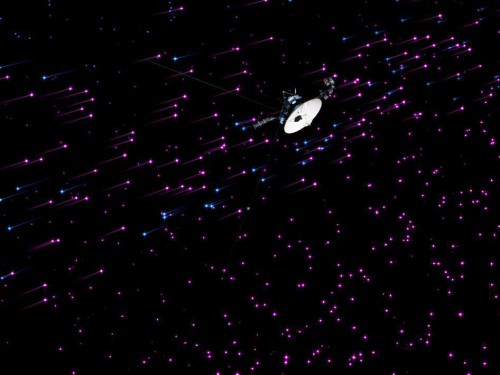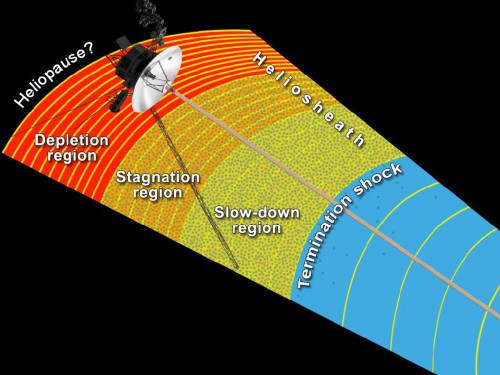
With a topic as complex as space exploration, confusion sometimes follows. Such has been the case with findings from NASA’s Voyager spacecraft. As the spacecraft edges further and further out into space, what it encounters is interpreted through the media as being “the edge of the solar system.” However, one NASA official pointed out that this is a misunderstanding.
“The Voyager team has never stated that Voyager 1 has left the solar system. It is close to leaving the heliosphere, which, to scientists, is not the same thing. The heliosphere is the bubble of charged particles the Sun blows around itself and is not the same as how scientists define the solar system gravitationally, which extends much further out to the Oort Cloud,” said Ed Stone, Voyager’s project scientist at the California Institute of Technology in Pasadena.
Voyager 1 is now estimated to be some 11 billion miles from the Sun. The spacecraft is poised to become the first man-made object to ever enter interstellar space.
“The Voyager team does think we are close to leaving the heliosphere since we are detecting so many interstellar particles. But we have seen no signs that we’ve gone beyond the influence of the Sun’s magnetic field into the embrace of the interstellar magnetic field. That’s why the team says we’re still inside the heliosphere. It is certainly a complicated region out there and unlike what scientists’ best-guess models have predicted. That’s the exciting part of exploration—you never know what you’re going to find,” Stone added.

These findings were announced in the journal Science detailing what is believed to be the last region of the solar system that Voyager 1 has to pass through before it leaves the heliosphere. The heliosphere is best described as a “bubble” that surrounds our Sun and its family of planets. The announcement in Science is but one of three papers that have been released on the subject.
Voyager 1 has entered into a region of space which has been dubbed the “magnetic highway.” A NASA-issued release detailed how charged particles from outside the heliosphere increased—as those originating from inside the heliosphere dwindle. These constitute two (of three) signs that suggest Voyager 1 has entered interstellar space. The final one, an abrupt change in the magnetic field, will suggest that the Sun’s influence has succumbed to the interstellar magnetic field.
“This strange, last region before interstellar space is coming into focus, thanks to Voyager 1, humankind’s most distant scout,” said Ed Stone. “If you looked at the cosmic ray and energetic particle data in isolation, you might think Voyager had reached interstellar space, but the team feels Voyager 1 has not yet gotten there because we are still within the domain of the Sun’s magnetic field.”
As for when Voyager 1 will actually reach interstellar space, scientists do not know when that will happen. It could take as little as several months—or as long as years. The heliosphere extends an estimated 8 billion miles beyond all of the planets in the Solar System outward from the Sun. It is powered by the various forces of the Sun. Outside this region, space is littered with matter from other stars.
Want to keep up-to-date with all things space? Be sure to “Like” AmericaSpace on Facebook and follow us on Twitter: @AmericaSpace




It is interesting to contemplate that there are spacecraft built by intelligent beings that have, maybe for the first time in the history of the universe, ventured into interstellar space. The twin Voyager spacecraft might very well be detected by another intelligent species and wouldn’t that be even more interesting if we could ever have THAT dialogue! Highly unlikely, of course, but a mind-boggling concept no less. Wow!
Tom, that dialogue may actually not be all that unlikely. In our 21st century world of high speed faster, faster, communication, travel, work, food . . . , we sometimes forget that has only been about four million years, a brief moment, a few ticks of the cosmic clock that our ancestors stood upright, learned that it probably wasn’t a good idea to eat excrement, and that an animal could be killed with a sharpened stick. Four thousand years ago we learned how to stack up rocks to build buildings and predict flooding of the Nile by looking at the stars. Four hundred years ago we burned witches. Forty years ago computers were the province of NASA, DOD, etc., and a small, cordless, hand-held telephone was the stuff of Star Trek. We can only imagine what life will be like four hundred, four thousand, or four hundred thousand years from now. Their incredibly advanced technology may seem as magic to us, as an iPad would to George Washington. An intelligent species may very well recover the Voyager spacecraft, but since NASA is giving serious thought to flight faster than light, who knows, it might be us! 🙂 In any event, the Pioneer and Voyager spacecraft were, without question, some of the best expenditures of tax dollars ever made. No “profit” accrued to anyone, but they generated a wealth of information, knowledge, technological advancement, inspiration, and national pride. Great post Tom, best wishes!
Surely it is not entering inter stellar space, as there is still a lot of objects Ie the Oort cloud to go through before entering the space between the stars.
Can someone clarify this point?
I would love to see another interstellar mission follow Voyager’s lead, particularly as higher performance ion propulsion like the NEXT engine has proven itself. One promising concept for such a mission: http://interstellarexplorer.jhuapl.edu/
Most emphatically agreed Matt. It is oft said, “From your lips, to God’s ear.” In this case, perhaps it should be, “From your lips, to the ear of Senator Nelson, Senator Shelby, Senator Mikulski, Representative Wolf, Representative Smith, et. al. . . .
The outermost influence of the Sun (with the exception of its light) is the heliopause, i.e. where the solar wind finally peters out. So beyond the point you are no longer in ‘stellar space’ (to coin a phrase). The theoretical Oort cloud is thought to be the remains of the cloud of gas and dust that collapsed inwards to form the Sun. Arguably it retains a loose connection with the Sun’s gravity well but its content is otherwise unaffected by the Sun.
We are not sure how far the Oort cloud extends. Some think 1 light year. I think it is farther. With the nearest star to earth about 4 light years away, I can easily imagine our Oort cloud extending the the lagrange point between us and that next star. Anything on our side of that gravity balance point would be more influenced by our sun. I wonder if it might be similar to molecular stucture of a solid where the outermost electron orbits of each atom touch. I expect less and less content in the Oort cloud the farther out we go, but think we will find stuff out to the half way point. Fun stuff to ponder.